
Restoration vs. Renovation: Understanding the Difference in Architectural Preservation
In the world of architecture, the terms restoration and renovation are often used interchangeably. But they represent distinct approaches to preserving and revitalizing structures. While both aim to enhance a building’s functionality and aesthetics, the methods employed and the ultimate goals of restoration and renovation differ significantly. This blog explores the nuances between restoration and renovation, emphasizing the importance of maintaining historical integrity versus introducing modern elements.
Restoration: Preserving the Past
Restoration involves returning a building to its original state, often focusing on a specific historical period. The goal is to preserve the architectural elements and materials of the original structure, carefully repairing and recreating any damaged or lost features. This process requires meticulous research and attention to detail, as architects and preservationists strive to capture the essence of the building’s historical significance.
Importance of Restoration:
- Preservation of Cultural Heritage: Restoration is crucial for maintaining the cultural and historical identity of a community. By preserving significant landmarks, we ensure that future generations can connect with the past.
- Architectural Authenticity: Restoring a building to its original design helps retain its authenticity. Original materials, construction methods, and architectural details are preserved to showcase the craftsmanship of the past.
- Educational Value: Restored structures serve as valuable educational tools, offering insights into the architectural styles and societal norms of the time. They become living history lessons for visitors and residents alike.
Renovation: Embracing Modernity
Renovation, on the other hand, involves making substantial changes to a building to update its functionality or appearance. This process often introduces modern elements, technologies, and materials to enhance the structure’s usability while respecting its overall form. Renovation allows for adaptation to contemporary needs without sacrificing the building’s basic identity.
Importance of Renovation:
- Adapting to Modern Lifestyles: Renovation allows buildings to evolve and cater to the changing needs of society. Spaces can be reconfigured to accommodate modern amenities and technologies.
- Sustainability: Renovating older structures can contribute to sustainability efforts by repurposing existing materials and reducing the need for new construction. This approach aligns with the principles of environmental responsibility.
- Preserving Functional Relevance: Renovation ensures that buildings remain functional and viable in the present day. It helps prevent the decay and abandonment of structures that might otherwise become obsolete.
Balancing Act: Finding Harmony Between Restoration and Renovation
In practice, the line between restoration and renovation is not always clear-cut, and many projects involve a combination of both approaches. Striking a balance between preserving historical integrity and meeting contemporary needs requires thoughtful consideration and collaboration between architects, preservationists, and communities.
Conclusion:
The decision to restore or renovate a structure hinges on the goals of the project and the significance of the building in question. While restoration keeps history alive by maintaining the original design and materials, renovation ensures that structures remain relevant and functional in the face of changing times. Ultimately, both restoration and renovation play vital roles in preserving architectural heritage and shaping the built environment for future generations. As stewards of our cultural legacy, it is our responsibility to make informed decisions that honor the past while embracing the future.






